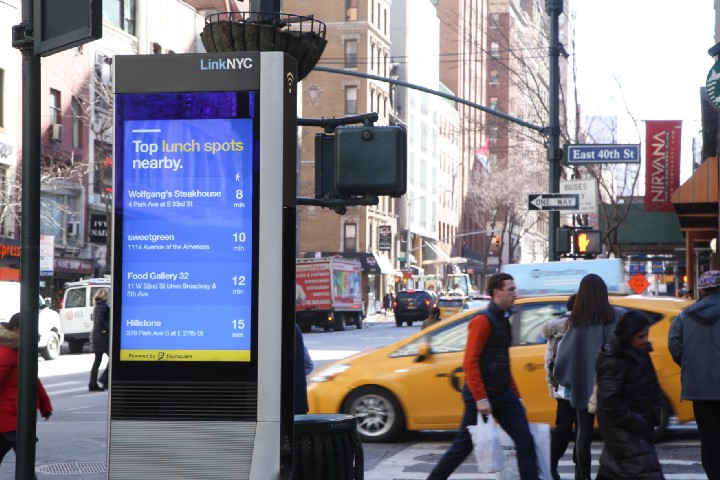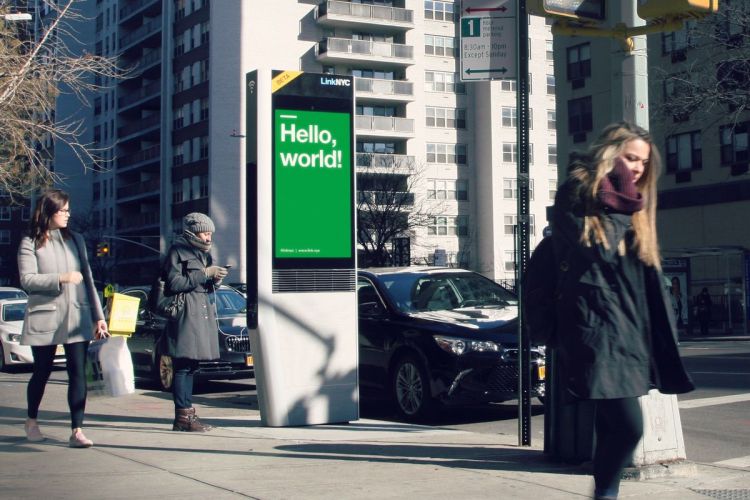What better way to replace New York City’s thousands of aging pay phones than with 9.5-foot-tall kiosks outfitted with 55-inch HD displays, gigabit internet, and Android tablets preloaded with informational apps? So went the thinking back in 2014, when then-mayor Michael Bloomberg launched a competition — the Reinvent Payphones initiative — calling on private enterprises, residents, and nonprofits to submit designs for spruced-up, publicly accessible hubs that would provide advertising-subsidized services to the public.
CityBridge’s LinkNYC beat out piezoelectric pressure plates, EV charging stations, and other competing proposals for a contract, and the consortium wasted no time in getting to work. Intersection — which with Qualcomm and CIVIQ Smartscapes manages the kiosks — said it plans to spend $200 million laying down 400 miles of new communication cables and installing as many as 10,000 Links that supply free Wi-Fi to passersby within a 150-foot radius. The first kiosk went online in January, though the project has quite a ways to go — 1,780 Links are active currently, short of the initial goal of 4,500 kiosks by July of this year. But many promised features — like buttons that link directly to 911 and New York’s 311 service, USB chargers, backup batteries, and a VoIP service that allows free calls to all 50 states and Washington, D.C. — made their way into the final design.
And the initial kiosks have really taken off. According to Intersection, the LinkNYC network now has more than 6 million unique users who have used 8.597 terabytes of data collectively — equivalent to about 1.3 billion songs or 292 billion WhatsApp messages. And the project facilitates 600,000 phone calls every month, up from 500,000 in September of last year.
People using the Links’ tethered tablets complete about 9,000 searches per month on the built-in social services directory and 311 app, Intersection says, with the most common search terms being: “work,” “housing health,” and “public benefits.” Almost 3 times the numbers of searches — 36,000 per month — are performed in the Maps app, the bulk of which are for “midnight run,” “food/clothing delivery,” “Best Buy,” and “movie theaters.”
June 5th: The AI Audit in NYC
Join us next week in NYC to engage with top executive leaders, delving into strategies for auditing AI models to ensure fairness, optimal performance, and ethical compliance across diverse organizations. Secure your attendance for this exclusive invite-only event.
The mishmash of metrics underscores the fact that for some New Yorkers, the Link hubs aren’t just a convenience — they’re a lifeline.
A 2015 study by the New York City Bureau of Policy and Research found that 25 percent of NYC residents don’t have home broadband internet, including 32 percent of unemployed residents. And according to a 2015 survey published by the city’s Department of Consumer Affairs, 44.5 percent of residents without an income didn’t own a cell phone or a service plan. It’s perhaps unsurprising, then, that the most-dialed number on Link hubs is the New York State Electronic Benefit Transfer (EBT) helpline, through which families can access Supplemental Nutrition Assistance Program (SNAP) benefits and other social support.

Four years ago, Mayor Bill De Blasio touted the Links as a sign of progress in the fight for a democratized internet. “[They’re] the fastest and largest municipal Wi-Fi network in the world,” he said, “[and] a critical step toward a more equal, open, and connected city for every New Yorker, in every borough.”
It bears mentioning that LinkNYC isn’t a philanthropic effort — investors extended $150 million in financing to Intersection in 2017. Moreover, despite the fact that revenue fell short of expectations in the first two years — the city collected $43.4 million in payments, narrowly beating the $42.5 million minimum CityBridge guaranteed — display ads, sponsorships, and partnerships on the Links are expected to generate between $500 million and a billion dollars over the next 12 years. (CityBridge and the city split the ad revenue equally; under an amended deal, CityBridge will delay paying the city its share of revenues above the minimum payments until the last year of the contract, when they’ll be due with 10 percent interest.)
That said, Intersection contends it’s doing its part to promote art, culture, and political participation through its army of kiosks. When the Links’ screens aren’t showing real-time bus arrivals and local maps, programming consists of rotating regular, seasonal, and limited-time content collaborations with organizations, publications, and government agencies. That includes headlines from the Associated Press, comics, weather info, and real-time alerts from the Office of Emergency Management, along with hundreds of hyperlocal factoids — dubbed “NYC Fun Facts” and “This Day in New York” — about people, places, and things.
To date, Intersection says it has showed 40 local artists, 2,000 local events, and 750 NYC Facts — oh, and seven marriage proposals.
On the civic engagement side of the equation, Intersection last April teamed up with the New York City Council to roll out Participatory Budgeting New York City, which let residents as young as 11 vote via the tablets on how the city will allocate a $1-million-per-neighborhood public budget. (This weekend marks the launch of its second year.) Intersection also launched an awareness campaign to get New Yorkers registered to vote in advance of the November 2018 general elections, and it circulates Community Board meeting notices and local road closures through its LinkLocal program, which lets small businesses advertise for free on select Links around the city.
Intersection says there were 14,473 tablet app sessions to access voter registration and voter information this past election cycle and that over 150 board meeting notices are on LinkNYC’s regular content rotation.
Encouraging as those stats might be, they’re unlikely to assuage Intersection’s loudest critics, some of whom — including the Intercept, the American Civil Liberties Union, Electronic Frontier Foundation, Stop LinkNYC, and ReThink LinkNYC — have brought attention to the hubs’ potential for mass surveillance. Each Link is equipped with three cameras capable of, among other things, “monitor[ing] pedestrian, bike, and car traffic; track[ing] passing wireless devices; listen[ing] to street noise; and … identify[ing] abandoned packages.”
Intersection says it makes clear in its privacy policy that it doesn’t collect information about users’ precise locations. In response to allegations that it intends to track Wi-Fi users’ real-time positions, Intersection says it doesn’t collect their clickstream data or browsing history. It also says that it doesn’t share data with third parties freely and makes “reasonable attempts” to notify affected users in the event it receives a data-pull request from a government agency.
Intersection added vision-assistance tools after the National Federation of the Blind sued the City of New York and LinkNYC, arguing that the tablets lacked basic accessibility features. (They’re now are fully compliant with the Americans with Disabilities Act of 1990.) And some advocacy groups have levied nuisance complaints against Intersection, claiming that the Links encourage loitering. The tablets initially had an internet browser, but engineers disabled it in response to complaints about users browsing pornographic material.
For better or worse, those bumps in the road haven’t dissuaded expansion. Beginning in 2017, in collaboration with British telecommunications company BT and British advertising agency Primesight, Intersection began installing hundreds of hubs in the U.K., including in London, Scotland, Wales, and Northern Ireland, where they’re branded LinkUK. Elsewhere, kiosks have been installed in the New Jersey city of Newark (LinkNWK), across the Hudson River from Manhattan, and on the busiest street corners in Philadelphia (LinkPHL).
“I think it’ll definitely be a combination of lessons learned and ensuring we add a little local flavor [to our programing],” Amanda Giddon, senior consumer marketing manager at Intersection, told VentureBeat in an earlier interview. “We have research teams in New York and Philadelphia who’ve conducted some preliminary focus group testing to understand how to best serve the community. We’re really open to feedback, and we’ve done a lot of work here and look forward to seeing how it’s received.”


